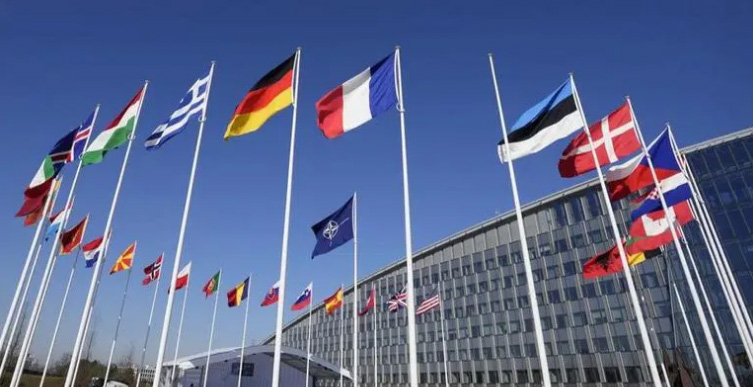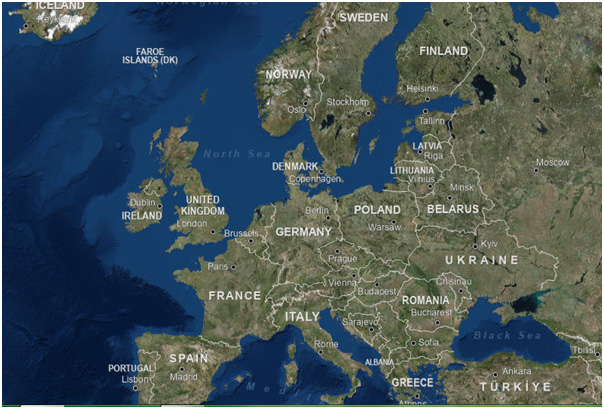Most unpalatable fallout of the ongoing Ukraine war for Russian Federation is perhaps Finland joining the North Atlantic Treaty Organisation (NATO) after securing Turkish Parliament’s ratification on 30 March. On 4 April, Finland’s Siniristilippu (Blue Cross Flag) was officially hoisted at the NATO’s headquarters in Brussels, Belgium to flutter amongst the 30 other ensigns of the member countries.
Along with Finland, another Nordic country Sweden had also applied for the NATO membership on 18 May 2022. Both had received invitation to join the alliance at the NATO’s Madrid Summit in June 2022. The accession protocols for both the countries were signed on 5 July 2022.
As per the NATO protocol all member countries are required to ratify the accession in their respective parliaments. By September 28, 2022, member countries had ratified the accession protocol.
Stung by bitter criticism of Prime Minister Viktor Orban’s policies by Helsinki and Stockholm, Hungary withheld the ratification till Finland’s diplomatic outreach mended the fences with Budapest. Finland was able to receive ratification from the Hungarian National Assembly on 27 March 2023. Sweden’s case is still pending.
Turkiye had more serious issues to settle with Helsinki and Stockholm. Ankara opposed Finnish and Swedish membership because of refusing its extradition requests for 33 individuals from Kurdistan Workers’ Party, a Kurdish militant political organisation operating in Kurdish majority region of south-eastern Turkiye. Taking a tough line President Recep Tayyip Erdogan said that admitting Finland and Sweden would turn NATO in to a hatchery for terrorists. Sweden’s refusal of arms sales to Turkiye since 2019 due to its military operation in Syriaonly aggravated the issue. However, sustained diplomatic parleys by Finland could mollify President Erdogan to secure ratification, but the ratification for Sweden’s membership is left in limbo.
Expansion of NATO follows an interesting trajectory aimed at cornering Russian Federation on its eastern borders and coasts abutting Europe. In 1949, 12 member countries Belgium, Canada, Denmark, France, Iceland, Italy, Luxembourg, the Netherlands, Norway, Portugal, the United Kingdom and the United States had founded the alliance, headquartered in London. During the Cold War four more countries, Greece and Turkiye (1952), West Germany (1955) and Spain (1958) were admitted in. Then only Norway shared a 195-km-long land border with the Soviet Union.
Near simultaneous strategic events such as fall of the Berlin Wall (1989), reunification of Germany (1990), dissolution of Warsaw Pact and breakup of the Soviet Union (1991) had a cataclysmic effect on the world order. The Soviet Union splintered into as many as 15 new nation states necessitating recalibration of strategic matrices.
Post-cold war expansion of NATO sowed the seeds of potential confrontation with Russia. In 1999, NATO admitted three former members of Warsaw Pact countries – Czechia (Czech Republic), Hungary and Poland. Alliance’s westward creeping-in had started.In 2004, seven more countries – Bulgaria, Estonia, Latvia, Lithuania, Romania, Slovakia and Slovenia joined the alliance. Baltic States Estonia, Latvia and Lithuania were the splinter nations of the erstwhile Soviet Union. This move bolstered NATO’s presence in the Baltic Sea – Denmark, Germany, Poland, Estonia, Latvia and Lithuania and the Black Sea – Turkiye, Romania and Bulgaria. NATO had now reached the Eastern borders of Russian Federation through Latvia and Estonia, while its exclave Kaliningrad in the Baltic Sea got wedged in between Poland and Lithuania. Russian uneasiness was palpable.
In April 2008, during the NATO’s Bucharest Summit, Albania and Croatia were invited to begin accession talks. A year later Albania and Croatiawere admitted. During the summit, Ukraine and Georgia were assured of their NATO membership and asked to work on the membership action plan. In 2017, Montenegro became the 29th member of the alliance and two years later North Macedonia also joined in. Post-cold war period accounts for 49 per cent of NATO’s expansion.
With Russia in doldrums, the United States emerged as undisputed leader of the unipolar world. The strategic environment that emerged needed deft diplomatic manoeuvring by Russia. Aneconomic cooperation initiative aimed at integrating European and Commonwealth of Independent States nations was best suited to thwart NATO’s creeping allurement in the region. With immense energy resources under its disposal and captive dependency of whole of Europe, Russia could have led amutually beneficial consortium.
To meet the challenges from its splinter countries Russia adopted a muscular approach. In August 2008, Georgia was invaded and its two provinces South Ossetia and Abakhazia were ‘liberated’. In March 2014, Russia ‘annexed’ Crimea from Ukraine. Concurrently, a separatists movement started in the Donbas region, which eight years later led to the current conflict. Russia’s invasion of Ukraine triggered a surge in Finnish and Swedish public opinion towards joining the alliance. Military interventions in the neighbourhood only hastened smaller states’ migration towards NATO.
Membership process for Finland and Sweden was fast-tracked to demonstrate NATO’s collective will and defiance to President Putin, but NATO is careful enough on according similar urgency in the case of Ukraine. Admitting Ukraine in the middle of the ongoing conflict would tantamount to armed intervention by NATO under its charter’s Article 5 of collective defence.
Finland’s admission in NATO will certainly impact Russian strategic interests, as it has a 1340-km-long border to worry about and its passage to St. Petersburg through the Gulf of Finland dominated by Finland and Estonia. Russian interests in the Baltic Sea have been severely impacted as all countries are now NATO members sans Sweden (for the time being). Russian exclave of Kaliningrad, which has silos for the nuclear capable short range ballistic missiles is hemmed in from all sides.
Situation is equally choppy in the Black Sea. With Turkiye, Bulgaria and Romania already NATO members and Ukraine and Georgia waiting in the wings, similar strategic disadvantage confronts Russia. Though by annexing Crimea, Sevastopol, Sea of Azov and better part of Black Sea coastline from Ukraine, Russia has improved its presence and position but Turkiye by the virtue of controlling the entry to Black Sea via Straits of Bosphorus and Dardanelles– on either end of the Seaof Marmara controlled by Turkiye–can still calls the shots. In the ongoing conflict, Russia has not been able to induct new battleships to make up for the battle losses in its Black Sea fleet.
Whatever is the outcome of Russia-Ukraine war, Ukraine and Georgia’s admission into NATO is a matter of time. Russia will have to share its land borders with Norway, Finland, Estonia, Ukraine and Georgia. NATO has contrived in hemming in a transcontinental nation on its Eastern borders and craftly formatted Cold War 2.0!







Ukraine strategy in Bakhmut is similar to Slim’s WW-2 strategy in and around kohima – a fighting retreat , all the while Inflicting heavy irreplaceable casualties on the enemy (Russia in this case) for a strategically insignificant Bakhmut (although Kohima was the key to Bengal) , while preparing for the counteroffensive.